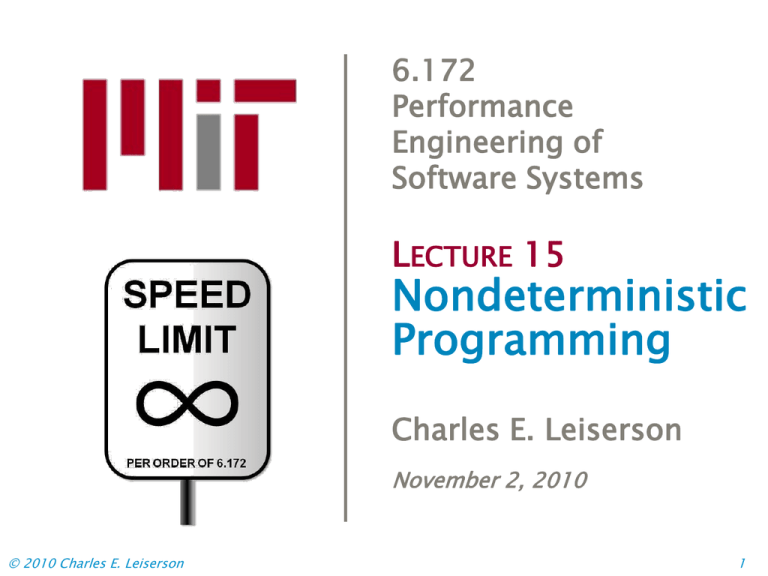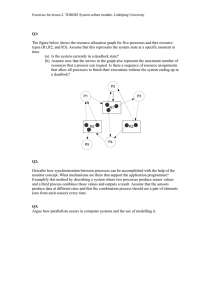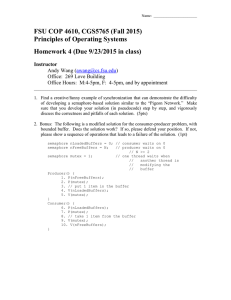
6.172
Performance
Engineering of
Software Systems
LECTURE 15
Nondeterministic
Programming
Charles E. Leiserson
November 2, 2010
© 2010 Charles E. Leiserson
1
Determinism
Definition. A program is deterministic on
a given input if every memory location is
updated with the same sequence of values
in every execution.
∙ The program always behaves the same way.
∙ Two different memory locations may be updated
in different orders, but each location always sees
the same sequence of updates.
Advantage: debugging!
© 2010 Charles E. Leiserson
2
Rule of Thumb
Always write
deterministic programs.
© 2010 Charles E. Leiserson
3
Rule of Thumb
Always write
deterministic programs,
unless you can’t!
© 2010 Charles E. Leiserson
4
OUTLINE
• Mutual Exclusion
• Implementation of Mutexes
• Locking Anomalies
• Deadlock
• Convoying
• Contention
© 2010 Charles E. Leiserson
5
OUTLINE
• Mutual Exclusion
• Implementation of Mutexes
• Locking Anomalies
• Deadlock
• Convoying
• Contention
© 2010 Charles E. Leiserson
6
Hash Table
92
39
51
42
33
12
15
94
26
77
75
34
16
x:
28
Insert x into table
81
1
2
3
© 2010 Charles E. Leiserson
slot = hash(x->key);
x->next = table[slot];
table[slot] = x;
7
Concurrent Hash Table
92
39
51
42
33
12
15
94
26
77
75
34
16
x:
y:
81
37
© 2010 Charles E. Leiserson
RACE
BUG!
28
1
2
6
slot = hash(x->key);
x->next = table[slot];
table[slot] = x;
3
4
5
slot = hash(y->key);
y->next = table[slot];
table[slot] = y;
8
Critical Sections
Definition. A critical section is a piece of
code that accesses a shared data structure
that must not be accessed by two or more
threads at the same time (mutual
exclusion ).
© 2010 Charles E. Leiserson
9
Mutexes
Definition. A mutex is an object with lock and
unlock member functions. An attempt by a thread
to lock an already locked mutex causes that thread
to block (i.e., wait) until the mutex is unlocked.
Modified code: Each slot is a struct with a mutex
L and a pointer head to the slot contents.
critical
section
© 2010 Charles E. Leiserson
slot = hash(x->key);
table[slot].L.lock();
x->next = table[slot].head;
table[slot].head = x;
table[slot].L.unlock();
10
Recall: Determinacy Races
Definition. A determinacy race occurs when
two logically parallel instructions access the
same memory location and at least one of the
instructions performs a write.
∙ A program execution with no determinacy races
means that the program is deterministic on that input.
∙ The program always behaves the same on that input,
no matter how it is scheduled and executed.
∙ If determinacy races exist in an ostensibly
deterministic program (e.g., a program with no
mutexes), Cilkscreen guarantees to find such a race.
© 2010 Charles E. Leiserson
11
Data Races
Definition. A data race occurs when two
logically parallel instructions holding no
locks in common access the same memory
location and at least one of the instructions
performs a write.
Cilkscreen understands locks and will not report a
determinacy race unless it is also a data race.
WARNING: Codes that use locks are
nondeterministic by intention, and
they weaken Cilkscreen’s guarantee
unless critical sections ―commute.‖
© 2010 Charles E. Leiserson
12
No Data Races ≠ No Bugs
Example
slot = hash(x->key);
table[slot].L.lock();
x->next = table[slot].head;
table[slot].L.unlock();
table[slot].L.lock();
table[slot].head = x;
table[slot].L.unlock();
Nevertheless, the presence of mutexes and
the absence of data races at least means that
the programmer thought about the issue.
© 2010 Charles E. Leiserson
13
Benign Races
Example: Identify the set of digits in an array.
A: 4, 1, 0, 4, 3, 3, 4, 6, 1, 9, 1, 9, 6, 6, 6, 3, 4
for (int j=0; i<10; ++i) {
digits[j] = 0;
}
cilk_for (int i=0; i<N; ++i) {
digits[A[i]] = 1; //benign race
}
digits:
1
1
0
1
1
1
1
0
0
1
0
1
2
3
4
5
6
7
8
9
CAUTION: This code only works correctly if the
hardware writes the array elements atomically —
e.g., it races for byte values on some architectures.
© 2010 Charles E. Leiserson
14
Benign Races
Example: Identify the set of digits in an array.
A: 4, 1, 0, 4, 3, 3, 4, 6, 1, 9, 1, 9, 6, 6, 6, 3, 4
for (int j=0; i<10; ++i) {
digits[j] = 0;
}
cilk_for (int i=0; i<N; ++i) {
digits[A[i]] = 1; //benign race
}
digits:
1
1
0
1
1
1
1
0
0
1
0
1
2
3
4
5
6
7
8
9
Fake locks allow you to communicate to
Cilkscreen that a race is intentional.
© 2010 Charles E. Leiserson
15
OUTLINE
• Mutual Exclusion
• Implementation of Mutexes
• Locking Anomalies
• Deadlock
• Convoying
• Contention
© 2010 Charles E. Leiserson
16
Properties of Mutexes
∙ Yielding/spinning
A yielding mutex returns control to the operating
system when it blocks. A spinning mutex consumes
processor cycles while blocked.
∙ Reentrant/nonreentrant
A reentrant mutex allows a thread that is already
holding a lock to acquire it again. A nonreentrant
mutex deadlocks if the thread attempts to reacquire
a mutex it already holds.
∙ Fair/unfair
A fair mutex puts blocked threads on a FIFO queue,
and the unlock operation unblocks the thread that
has been waiting the longest. An unfair mutex lets
any blocked thread go next.
© 2010 Charles E. Leiserson
17
Simple Spinning Mutex
Spin_Mutex:
cmp 0, mutex ; Check if mutex is free
je Get_Mutex
pause ; x86 hack to unconfuse pipeline
jmp Spin_Mutex
Get_Mutex:
mov 1, %eax
xchg mutex, %eax ; Try to get mutex
cmp 0, eax ; Test if successful
jne Spin_Mutex
Critical_Section:
<critical-section code>
mov 0, mutex ; Release mutex
Key property: xchg is an atomic exchange.
© 2010 Charles E. Leiserson
18
Simple Yielding Mutex
Spin_Mutex:
cmp 0, mutex ; Check if mutex is free
je Get_Mutex
call pthread_yield ; Yield quantum
jmp Spin_Mutex
Get_Mutex:
mov 1, %eax
xchg mutex, %eax ; Try to get mutex
cmp 0, eax ; Test if successful
jne Spin_Mutex
Critical_Section:
<critical-section code>
mov 0, mutex ; Release mutex
© 2010 Charles E. Leiserson
19
Competitive Mutex
Competing goals:
∙ To claim mutex soon after it is released.
∙ To behave nicely and waste few cycles.
IDEA: Spin for a while, and then yield.
How long to spin?
As long as a context switch takes. Then, you
never wait longer than twice the optimal time.
∙ If the mutex is released while spinning, optimal.
∙ If the mutex is released after yield, ≤ 2 × optimal.
Randomized algorithm: e/(e–1)-competitive.
© 2010 Charles E. Leiserson
20
OUTLINE
• Mutual Exclusion
• Implementation of Mutexes
• Locking Anomalies
• Deadlock
• Convoying
• Contention
© 2010 Charles E. Leiserson
21
OUTLINE
• Mutual Exclusion
• Implementation of Mutexes
• Locking Anomalies
• Deadlock
• Convoying
• Contention
© 2010 Charles E. Leiserson
22
Deadlock
Holding more than one lock at a time can
be dangerous:
Thread 1
1
A.lock();
B.lock();
critical section
B.unlock();
A.unlock();
Thread 2
2
B.lock();
A.lock();
critical section
A.unlock();
B.unlock();
The ultimate loss of performance!
© 2010 Charles E. Leiserson
23
Conditions for Deadlock
1. Mutual exclusion — Each thread claims
exclusive control over the resources it
holds.
2. Nonpreemption — Each thread does
not release the resources it holds until
it completes its use of them.
3. Circular waiting — A cycle of threads
exists in which each thread is blocked
waiting for resources held by the next
thread in the cycle.
© 2010 Charles E. Leiserson
24
Dining Philosophers
C.A.R. Hoare
Edsger Dijkstra
Hoare photo © David Monniaux. CC by-sa. Dijkstra photo © source unknown. All rights reserved.
This content is excluded from our Creative Commons license. For more information, see http://ocw.mit.edu/fairuse.
Illustrative story of deadlock told by Charles
Antony Richard Hoare based on an examination
question by Edsgar Dijkstra. The story has been
embellished over the years by many retellers.
© 2010 Charles E. Leiserson
25
Dining Philosophers
Each of n philosophers needs
the two chopsticks on
either side of his/her
plate to eat his/her
noodles.
Philosopher i
while (1) {
think();
chopstick[i].L.lock();
chopstick[(i+1)%n].L.lock();
eat();
chopstick[i].L.unlock();
chopstick[(i+1)%n].L.unlock();
}
© 2010 Charles E. Leiserson
Dining philosophers image © source unknown.
All rights reserved. This content is excluded from
our Creative Commons license. For more
information, see http://ocw.mit.edu/fairuse.
26
Dining Philosophers
Starving
Each of n philosophers needs
the two chopsticks on
either side of his/her
plate to eat his/her
noodles.
One day they all pick
Philosopherup
i their left chopsticks
while (1) {
simultaneously.
think();
chopstick[i].L.lock();
chopstick[(i+1)%n].L.lock();
eat();
Dining philosophers image © source unknown.
chopstick[i].L.unlock();
All rights reserved. This content is excluded from
our Creative Commons license. For more
chopstick[(i+1)%n].L.unlock();
information, see http://ocw.mit.edu/fairuse.
}
© 2010 Charles E. Leiserson
27
Preventing Deadlock
Theorem. Suppose that we can linearly
order the mutexes L1 ⋖ L2 ⋖ ⋯ ⋖ Ln so that
whenever a thread holds a mutex Li and
attempts to lock another mutex Lj , we
have Li ⋖ Lj . Then, no deadlock can occur.
Proof. Suppose that a cycle of waiting exists.
Consider the thread in the cycle that holds the
―largest‖ mutex Lmax in the ordering, and suppose
that it is waiting on a mutex L held by the next
thread in the cycle. Then, we must have Lmax ⋖ L .
Contradiction. ∎
© 2010 Charles E. Leiserson
28
Dining Philosophers
Philosopher i
while (1) {
think();
chopstick[min(i,(i+1)%n)].L.lock();
chopstick[max(i,(i+1)%n)].L.lock();
eat();
chopstick[i].L.unlock();
chopstick[(i+1)%n].L.unlock();
}
© 2010 Charles E. Leiserson
Dining philosophers image © source unknown.
All rights reserved. This content is excluded from
our Creative Commons license. For more
information, see http://ocw.mit.edu/fairuse.
29
Deadlocking Cilk++
void main() {
cilk_spawn foo();
L.lock();
cilk_sync;
L.unlock();
}
void foo() {
L.lock();
L.unlock();
}
1
[
[
2
3
main()
waits.
]
]
foo() waits.
∙Don’t hold mutexes across cilk_sync’s!
∙Hold mutexes only within strands.
∙As always, try to avoid using mutexes
(but that’s not always possible).
© 2010 Charles E. Leiserson
30
OUTLINE
• Mutual Exclusion
• Implementation of
Mutexes
• Locking Anomalies
• Deadlock
• Convoying
• Contention
© 2010 Charles E. Leiserson
31
Performance Bug in MIT-Cilk
When random work-stealing, each thief
grabs a mutex on its victim’s deque:
∙ If the victim’s deque is empty, the thief releases
the mutex and tries again at random.
∙ If the victim’s deque contains work, the thief
steals the topmost frame and then releases the
mutex.
PROBLEM: At start-up, most thieves quickly
converge on the worker P0 containing the
initial strand, creating a convoy.
© 2010 Charles E. Leiserson
32
Convoying
© 2010 Charles E. Leiserson
33
Convoying
© 2010 Charles E. Leiserson
34
Convoying
© 2010 Charles E. Leiserson
35
Convoying
© 2010 Charles E. Leiserson
36
Convoying
The work now gets distributed slowly as
each thief serially obtains P0’s mutex.
© 2010 Charles E. Leiserson
37
Solving the Convoying Problem
Use the nonblocking function try_lock(),
rather than lock():
∙ try_lock() attempts to acquire the
mutex and returns a flag indicating
whether it was successful, but it does not
block on an unsuccessful attempt.
In Cilk++, when a thief fails to acquire a
mutex, it simply tries to steal again at
random, rather than blocking.
© 2010 Charles E. Leiserson
38
OUTLINE
• Mutual Exclusion
• Implementation of Mutexes
• Locking Anomalies
• Deadlock
• Convoying
• Contention
© 2010 Charles E. Leiserson
39
Summing Example
int compute(const X& v);
int main()
{
const std::size_t n = 1000000;
extern X myArray[n];
// ...
int result = 0;
for (std::size_t i = 0; i < n; ++i)
{
result += compute(myArray[i]);
}
std::cout << "The result is: "
<< result
<< std::endl;
return 0;
}
© 2010 Charles E. Leiserson
40
Summing Example in Cilk++
int compute(const X& v);
int main()
{
const std::size_t n = 1000000;
extern X myArray[n];
// ...
Work = Θ(n)
Span = Θ(lg n)
Running time =
O(n/P + lg n)
int result = 0;
cilk_for (std::size_t i = 0; i < n; ++i)
{
result += compute(myArray[i]);
}
std::cout << "The result is: "
<< result
<< std::endl;
return 0;
Race!
}
© 2010 Charles E. Leiserson
41
Mutex Solution
int compute(const X& v);
int main()
{
const std::size_t n = 1000000;
extern X myArray[n];
// ...
Work = Θ(n)
Span = Θ(lg n)
Running time =
Ω(n)
int result = 0;
mutex L;
cilk_for (std::size_t i = 0; i < n; ++i)
{
L.lock();
result += compute(myArray[i]);
L.unlock();
}
std::cout << "The result is: "
⇒ no
<< result
<< std::endl;
parallelism!
return 0;
Lock
contention
}
© 2010 Charles E. Leiserson
42
Scheduling with Mutexes
Greedy scheduler:
TP ≤ T1/P + T∞ + B ,
where B is the bondage — the total time of
all critical sections.
This upper bound is weak, especially if
many small mutexes each protect different
critical regions. Little is known theoretically
about lock contention.
© 2010 Charles E. Leiserson
43
Rule of Thumb
Always write
deterministic programs.
© 2010 Charles E. Leiserson
44
Rule of Thumb
Always write
deterministic programs,
unless you can’t!
© 2010 Charles E. Leiserson
45
MIT OpenCourseWare
http://ocw.mit.edu
6.172 Performance Engineering of Software Systems
Fall 2010
For information about citing these materials or our Terms of Use, visit: http://ocw.mit.edu/terms.






